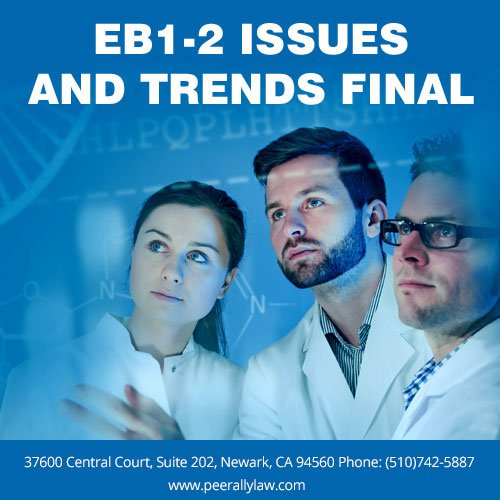What is the EB-1-2 or EB1-B and what are the common issues related to this application?
One way to obtain an immigrant visa in the United States is to be an outstanding professor or researcher. This classification is known as the EB-1-2 also known as the EB1 B Outstanding Researcher category.

The Outstanding Researcher category is often used by researchers and scientists, whether employed by universities, non-profit research organizations, or for-profit pharmaceutical or biotechnology companies. Outstanding Researcher category, if it is appropriate, offers clear advantages: it avoids the Department of Labor (DOL)-driven PERM process entirely, and, it places the foreign national in the EB-1 category. Note that the EB1 categories are usually current on visa bulletins. Moreover, the Outstanding Researcher category is broad enough to encompass academic fields in the hard sciences, social sciences, and humanities. While the application might seem fairly easy, there are many issues that are regularly encountered by applicants.
- ISSUES REGARDING THE PETITIONING INSTITUTION
1.A “Permanent Offer of Employment” –
-
EB-1 B cases require that the sponsoring institution file a petition on behalf of the beneficiary; he or she cannot self-petition. Unlike the EB1 A, you need an entity to petition for an EB1 B. Moreover, the petitioner must have offered the beneficiary a permanent, full-time position. The regulation states that “[p]ermanent, in reference to a research position, means either tenured, tenure-track, or for a term of indefinite or unlimited duration, and in which the employee will ordinarily have an expectation of continued employment unless there is good cause for termination. This means that just an offer with no definite parameters accordingly to the law will not be enough to obtain an EB1B.
Requirements of a “permanent offer of employment” under this immigrant category –
- According to the USCIS memo from June 2006, Permanent Offer” “permanent” requirement refers to research positions only, and not to a non-research professor position, which must be shown to be tenured or tenure-track.
-
Thus, an Outstanding Researcher petition may be approvable even without an employment agreement containing a “good cause for termination” clause if the sponsoring employer can show that the offer is intended to be “of an indefinite or unlimited duration and that the nature of the position is such that the employee will ordinarily have an expectation of continued employment.”
Tips –
-
In addition to submission of evidence of a history of prior grant renewals, the petitioner should submit clear evidence that it intends to seek continued funding for the position, either in its letter in support of the petition or ideally, in the offer letter itself.
-
Even in a case where a written employment agreement is valid for one year, evidence of the renewal or extension of earlier employment agreements with this same employee, or others in the research team, and other documentation of the expected long-term nature of the research of the department or division would serve to demonstrate this key requirement.
- If a temporary position is renewable in this manner, the job offer may not qualify as “permanent” if the individual is restricted to a limited number of re appointments. USCIS may look to the petitioner’s human resource manual to determine the nature of the position offered maximum of three years
Form of a letter from the petitioner addressed to the beneficiary –
-
Another, related issue in past cases involved the AAO’s finding that the job offer be evidenced in the form of a letter from the petitioner addressed to the beneficiary and not to the immigration authorities.
-
In one opinion, the AAO stated that an offer letter from a department head should not be given any weight without evidence (typically from the personnel department) that the individual signing the letter had been granted the authority to hire permanent employees Several of the decisions noted the requirement that the formal job offer letter must pre-date the petition’s filing date.
-
The prudent approach in such cases is to seek and include an offer letter written by someone at the institution who has actual hiring authority and directed to the foreign national.
2. At Least Three Persons Full-Time in Research Activities –
-
Petitioners for EB-1-2 cases must demonstrate employment of “at least three persons full-time in research activities.”
-
The additional persons need not be of the same outstanding caliber as the beneficiary, as long as they are engaged in full-time research in the beneficiary’s field. Potential issues could be raised if the beneficiary has a different field of study than the other researchers employed by the petitioner. To avoid this, the entire research team should be presented as working toward a common goal.
Tips –
-
A petitioner’s annual report or similar publication often includes information on the types and numbers of employed staff, including job titles, such as “researcher.”
-
Similarly, the organization’s mission statement and description of past and current achievements or milestones in such a publication can constitute valuable evidence that it meets this requirement.It is also important to include independent websites that report glowingly of the petitioner’s accomplishments, and to mention them in at least one of the independent expert support letters.
-
It is important to note that the AAO has been known to enter DOL’s Occupational Outlook Handbook into the record of proceedings when delving into the nature of an employment position. If it is difficult to fit the beneficiary into a research position, or to prove that the petitioner employs at least three other full-time researchers, it may benefit Applicants to consult the Occupational Outlook Handbook to weigh the possible deleterious effects of job titles.
3. Employer’s Ability to Pay
Tips –
-
Most have been able to file EB-1-2 cases have been successful in excluding “Ability to Pay” documentation and just including evidence of an established research program.
-
Regulations require “Ability to Pay” documentation for every employment-based immigrant visa petition that is based on a job offer. “Ability to Pay” documentation is considered “initial evidence” and based on telephone communication with Service Center adjudicators, a Form I-140, Immigrant Petition for Alien Worker, can be denied without a Request for Evidence (RFE) for lack of initial evidence.
-
Avoid potential problems by submitting appropriate “Ability to Pay” documentation at the time of initial filing.
- EVIDENTIARY ISSUES
1. Three Years of Research Experience
-
According to 8 CFR §204.5(i)(3), evidence of research experience “shall be in the form of letter(s) from former or current employers and shall include the name, address, and title of the writer, and a specific description of the duties performed by the alien.”
-
Evidence of having presented research findings at international conferences and/or publication of related articles in peer-reviewed journals also will serve to corroborate fulfilment of this criterion.
-
There may be more scrutiny for the cases where the three years of research experience is just met.
-
The Outstanding Researcher regulations specifically note that experience gained while completing an advanced degree may be counted toward the requisite “three years” if the foreign national acquired the degree, and if the research he or she conducted toward the degree in the academic field has been “recognised as outstanding.” Of past AAO decisions, only a few hinged on the regulatory option that pre-doctoral research counts toward the three-year requirement.
-
In such a case, the petition must clearly document the outstanding nature of any pre-doctoral research, and consider a NIW or a PERM labor certification if that research is not outstanding. Paid research assistant work, for example, is treated with suspicion, and must be carefully distinguished from the basic research involved in the doctoral degree
2. Peer Letters of Recommendation –
-
AAO decisions have routinely held that “letters containing mere assertions of widespread recognition and vague claims of contributions are less persuasive than letters that specifically identify contributions and provide specific examples of how those contributions have influenced the field
-
A combination of letters from collaborators and mentors who describe the beneficiary’s reputation in the field, along with a few other letters from independent references who know the beneficiary’s work via their conference presentations or publications, is the best recipe for success.
-
Moreover, it is possible that many letters may sound repetitive. A total of five to seven letters seems reasonable given the amount of time the adjudicator has to review each petition.
3. Receipt of Major Prizes or Awards for Outstanding Achievements –
Short list of awards submitted that held little or no weight in the appeals process because they did not establish international recognition:
- Student prizes, including graduate fellowships;
-
Beneficiary having made the Dean’s List or received merit awards: “Student awards for which only students compete are not major prizes or awards such that they are indicative of international recognition”;
-
Awards granted by the petitioner, including internal research funding awards and bonuses;
- Travel awards;
- Teaching assistant awards;
- Elected student officer positions;
- Receipt of a high score on an admissions examination;
- Acceptance for publication;
- Research fellowships, unless granted on the basis of prior significant achievement;
-
Grants for new work – Grants do not fall cleanly into any of the six regulatory criteria for EB-1-2 classification. You can document that the reason for funding by the granting agency was based on recognized past accomplishments (e.g., documented either by the peer reviews for the grant or in the peer reference letters for the EB-1-2 petition). The same is true for research or medical fellowships. The grant must be related to the beneficiary’s field of endeavor.
-
A shared prize or award resulting from collaborative work should not be considered any less prestigious for that reason alone.
4. Membership in Associations –
-
For a membership to have weight in this category there must be a higher selective standard for admission to the association. The practitioner should submit evidence of selective membership criteria along with evidence of membership in the association. The association must be related to the beneficiary’s field of endeavor.
Tips –
-
Although mere membership in an association in one’s field without evidence of membership criteria beyond payment of dues does not fulfil this criterion, the petition may include evidence of the beneficiary’s unique or selected role within such an association, such as being invited to serve on a steering committee etc.
-
The AAO decisions state clearly that this criterion is intended for the “most prestigious associations, such as the National Academy of Sciences, which are extremely restrictive in their membership requirements.
-
If the professional associations to which the beneficiary belongs do not rise to the level of fulfilling this criterion, then leave them out altogether. Do not assume “it can’t hurt to include it” because it can. Including unpersuasive evidence only gives fodder to the adjudicator on which to base a denial.
5. Published Material About the Person –
-
To satisfy this criterion, the published material should be at the national or international level.
-
Articles in local newspapers, university publications, or the petitioner’s internal reports do not qualify. Moreover, standard academic citations do not count as published material “about” the beneficiary.
-
Publications that may meet this criterion are trade or academic journals that feature the beneficiary and/or his or her work; internationally circulated newspapers that report on the beneficiary and/or the beneficiary’s employer, if the article discusses the research work for which the beneficiary is known.
6. Participation as a Judge of the Work of Others –
-
Reviewing grants or articles can satisfy this criterion if the review request is directed particularly to the beneficiary. All invitations to review should be accompanied with confirmation that the reviewing actually took place; invitations alone are not sufficient.
-
To fulfil this criterion, a position as a member of a journal editorial board is ideal. In such a position, the beneficiary “provides policy guidance in addition to reviewing manuscripts,” and is “not simply one of the journal’s numerous peer-reviewers.
Tips –
-
If possible, include evidence that the beneficiary was in fact “judging” the grant proposal or article by including a copy of the beneficiary’s comments and, even better; include evidence that the beneficiary’s comments were accepted by the applicant submitting the grant proposal or article.
7. Original Scientific or Scholarly Research Contributions to the Academic Field –
-
AAO has concluded: “it does not follow that every published article represents an original contribution demonstrative of outstanding research or an international recognition. If we were to hold otherwise, then every alien who has published a scholarly article in an internationally circulated journal would automatically qualify as outstanding, which would clearly go against the intent of the regulations.”
-
Patents or patent applications also carry little weight unless they demonstrate an international reputation in the field. Applicants should document the widespread use or application of the patent.
-
Peer letters of recommendation can play an important role in demonstrating original contributions.
8. Authorship of Scholarly Books or Articles –
-
The publications must be in peer-reviewed academic journals, preferably those with international circulation. When submitting evidence under this category, the practitioner must demonstrate that the publication record rises above that of the average researcher. One method of doing so is to show that the beneficiary’s papers have been widely cited by independent researchers in the field.
-
It also helps to have the peer recommendation letters include references to specific papers, their impact, the beneficiary’s contribution, and that they appeared in prestigious journals of international circulation. This can be particularly important when the beneficiary is listed as “co-author” on all or most articles.
-
Evidence of the articles’ “significant international distribution from independent sources[,] such as media guides or the publishers themselves” can also be helpful to demonstrate international circulation
Tips –
- Noting the impact of an article in subjective terms, where appropriate, can be helpful.
- Other points raised by the AAO include:
- Published abstracts do not carry the same weight as full-length articles.
-
Articles published in only one country with only domestic circulation, such as many Chinese medical journals do not satisfy the international-reputation standard.
- “An unpublished manuscript is not published material.”
-
USCIS service centers do send RFEs asking for proof that the beneficiary is a key independent researcher in a group project. Therefore, as noted above, Applicants should clearly document the role of the beneficiary in a research team, especially if the beneficiary is not first author on any articles that result from the work.
- Comparable Evidence –
-
Unlike the regulations governing the EB-1-1 Extraordinary Ability category that specifically allow for comparable evidence, there is no provision for comparable evidence in the Outstanding Researcher regulations.
- Non-traditional Researchers –
-
Outstanding Researcher category also affords a route to lawful permanent residence for those employed in other, perhaps “less traditional” fields. Petitioners—academic, non-profit and private—have successfully utilized the EB-1-B category for those specialized in such fields as economics, law, and human rights. However, with the exception of universities, state agencies are ineligible to petition in the EB1-B category.
-
An Outstanding Researcher petition for a beneficiary in a less-than-traditional field might include evidence that U.S. universities do offer degree or certificate programs in the particular field as a means of demonstrating that the field itself is “academic.”
-
In preparing such a “non-traditional” petition, it may be necessary to point out that “research,” while traditionally thought of as basic research, also includes “applied” research. USCIS’s regulations for Outstanding Researcher petitions are silent on this point.
Tips –
-
Applicants should consider all possible avenues for a beneficiary in a non-traditional research field, including self-sponsorship under the EB-1-1 category or a NIW petition.
-
The evidence in a “non-traditional” filing also may vary somewhat from the standard publications, articles, and citations found in nearly every scientific researcher petition. In “non-traditional” cases, the beneficiary may have op-ed pieces in international newspapers in which he or she offers an expert viewpoint based on years of study in the field.
-
Unlike the published material in a scientific journal about a beneficiary’s work, an individual in a “non-traditional” field might have television or radio appearances in which he or she was interviewed as an expert for a more general and wider audience. The practitioner must find a way to include such evidence within the often-traditionally viewed and somewhat narrow criteria categories of the Outstanding Researcher regulations.
- Burden of Proof
-
The burden of proof on the petitioner is the “preponderance of the evidence,” meaning the evidence must show that the claim is probably true.
-
It is not necessary to prove any claim beyond a reasonable doubt. Reasonably supported claims evidencing that the beneficiary meets at least two of the six criteria should result in granting of the classification sought, regardless of any doubts held by the adjudicating officer.
- Conclusion –
If an EB-1-B petition fails, the AAO decisions argue against filing an appeal. Appeals to the AAO can take one year or longer to be decided. They are very unlikely to lead to reversal. We suggest the following alternatives:
-
File the Form I-140 again, with whatever additional publications or other materials are available, addressing the reasons for the initial denial.
-
Consider filing an EB-1-1 or NIW petition if the beneficiary is one of the top few in his or her field, or if he or she has made a significant accomplishment in a field of national interest.
-
Consider PERM labor certification, which allows restrictive requirements based on business necessity, and can help focus on the beneficiary’s particular skills required by the petitioner.
-
Finally, do not forget to ask about other paths to lawful permanent residence, including family-based sponsorship, spouse’s employment-based options, the diversity visa lottery program, or asylum.
(This article has been modified from an article “EB-1-2 Outstanding Researcher Cases: Issues and Trends” published on AILA.)

